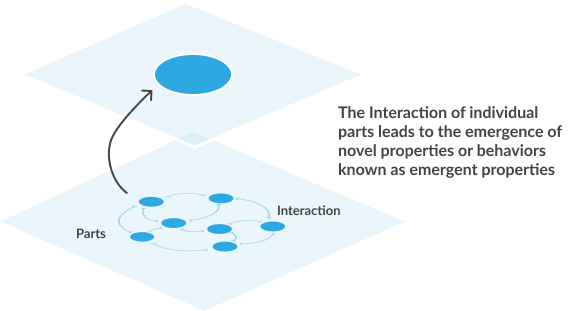Are you looking for ways to better understand the complexity of the world around you? Are you finding it increasingly difficult to navigate through all the unexpected challenges, changes and unpredictable dynamics? If so, then understanding emergence could be your answer.
Emergence is a concept that systems thinkers have used for years as a means of exploring and gaining insight into how complex behaviour arises from seemingly simple interactions within an environment. In this article, we’ll explore what emergence is in greater detail and outline key ideas associated with its core principles.
Prolific British psychologist G. H. Lewes was the first to bring attention to the principles of emergent behavior with his multivolume work, problems of life and mind (Corning, 2002).
The philosophy behind emergence or emergent properties is that complex systems exhibit novel properties and behaviours that cannot be reduced to or explained by the properties of their individual components or parts. Emergent properties are properties that arise from the interactions and relationships among the parts of a system and cannot be predicted or fully understood by analyzing each part in isolation.
The idea of emergence challenges reductionism, which suggests that complex systems can be understood by breaking them down into their individual parts and studying them in isolation. Instead, emergent properties suggest that the whole is more than the sum of its parts, and understanding complex systems requires understanding the relationship between the parts and how they interact with one another.
Emergence is what “self-organizing” processes produce (Corning, 2002) and refers to the arising of novel and coherent structures, patterns, and properties during the process of self-organization in complex systems as shown in figure 1.

Emergent phenomena are conceptualized as occurring on the macro level, in contrast to the micro-level components and processes out of which they arise. (Goldstein, 1999). It is a fundamental concept and can be observed in a wide range of systems, from mechanical, biological domains all the way up to its appearance in cultural and political spheres and accounts for the presence of hurricanes, ecosystems, complex organisms like humans, and also phenomena like traffic congestion and organization culture.
Also Read : Decoding the complexity: unveiling the power of systems modelling in today’s world
Examples of emergent properties
The following examples demonstrate how emergence manifests in various systems:
- Life is an emergent property because it arises from the interactions between many different body parts. For example, the heart, lungs, and circulatory system work together to deliver oxygen and nutrients to all the cells in the body. The digestive system takes in food and extracts nutrients that are then used by the body for energy and growth. The nervous system coordinates all of the body’s functions and allows us to perceive and respond to our environment. And the immune system protects the body against disease and infection. All of these different parts of the body interact with each other in complex ways and give rise to the emergent property of life.
- Art is another example of an emergent property because each brush stroke, colour choice, and compositional decision made by the artist interacts with one another to create the final artwork. Furthermore, the viewer’s interpretation and experience of the artwork is also an emergent property. Each individual brings their unique perspective and understanding to the artwork, influenced by their own.
- Organizational culture is an emergent property that originates from the complex interactions between different components of an organization. It cannot be created directly or imposed from top-down; rather, it evolves over time as a result of the beliefs, behaviors, values, and practices of individuals within the organization.
- Various aspects of the organization, such as people, processes, structure, and environment, contribute to the emergence of organizational culture. These elements interact with each other in intricate ways to give rise to the unique culture of the organization.
- Team performance exemplifies an emergent property, arising from the interactions between team members. The defining factor of a winning team is not solely the individual capabilities of its members but rather the quality of the interactions between them. Having clear goals, well-defined roles, open communication, trust, adaptability, and accountability can enhance the quality of interactions and result in the emergence of a high-performance team.
- Driving a car is a great example of an emergent property in action. It involves the interaction of various parts of the car, the driver, and the environment. The car itself is a complex system made up of many interconnected components, including the engine, transmission, brakes, suspension, and tires. Each of these parts has a specific function and interacts with the others in a coordinated way to produce the emergent property of driving. The emergent property of driving arises from the coordinated interaction of all these parts – the car, the driver, and the environment – in a way that cannot be predicted or reduced to the properties of any individual part in isolation. It is a complex system in which the whole is more than the sum of its parts.

Embark on Transformation
Start the Systems Thinking learning journey and become an expert in navigating intricate landscapes.
Characteristics of emergence
Holmen’s book, “Engaging Emergence,” outlined the following five distinct features that underpin emergence (Holmen , 2011)
1. Radical novelty:
At each level of complexity, entirely new properties appear (for example, from autocracy—rule by one person with unlimited power—to democracy, where people are the ultimate source of political power)
2. Coherence:
A stable system of interactions (an elephant, a biosphere, an agreement)
3. Wholeness:
Not just the sum of its parts, but also different and irreducible from its parts (humans are more than the composition of lots of cells)
4. Dynamic:
Always in process, continuing to evolve (changes in transportation: walking, horse and buggy, autos, trains, buses, airplanes)
5. Downward causation:
The system shaping the behavior of the parts (roads determine where we drive)
Emergence, a valuable tool for systems thinkers
Emergence offers a valuable tool for systems thinkers. It is not only a key concept, but also serves as the foundation for the other systems thinking concepts like holism, modelling and boundaries. Following is a summary on five thinking paths of emergence for systems thinkers from the book “The Grammar of Systems: From Order to Chaos & Back” by Patrick Hoverstadt (Hoverstadt , 2022),
What is the emergent of this system?
What is emerging from the system by examining its boundaries, relationships, and dynamics.
What is the system of this emergent?
This is the most common and natural flow systems thinkers use when addressing problems. Recognize the problem as emergent property and then seek to understand what nature of the system it creates and how it does that.
How do emergent change the system?
How emergent properties affects all elements within a system, not just the behavior of the whole.
Emergent through time.
The parts, system, and emergent properties are all dynamic, interdependent, and constantly changing.
The invisible hand or “outrageous fortune”.
The post-enlightenment worldview is based on the belief that understanding the world gives us control over it, in contrast to ancient views, which held to a belief in non-rational forces limiting human power. Political and media discussions often involve emergent properties, which systems thinking tries to understand and move beyond seeing as just chance events. Emergence marks our limits.
Systems thinking is undeniably dependent on the idea of emergence. It encapsulates philosophies behind complexity, transformation, and environmentally enriching interactions. In essence, it enables systems thinkers to continuously gain insight when attempting to understand how the parts create the whole while challenging accepted patterns of order and control.
The properties that emerge from the interaction of parts may be intended (improved productivity) or unintended (global warming, refugee crises) or both. This is the place where systems thinking approaches can help to guide processes of deliberation to improve and develop a more desirable future.
Conclusion
Emergence evokes belief in the interactivity between entities, resulting in deeper resonance and prompts systems thinkers to see the world in a more interconnected and holistic way which can enhance ability to understand and influence outcomes. Therefore, it can be concluded that emergence is not simply an essential systems thinking concept – it is its beating heart.


